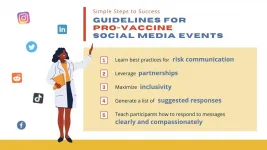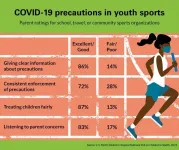(Press-News.org) CHAMPAIGN, Ill. -- In a state with greater income inequality, the happiest place to occupy is not at the pinnacle of the income distribution, as one might think, but somewhere in the middle that provides clear vantage points of people like ourselves, a new study suggests.
According to sociologist Tim Liao of the University of Illinois Urbana-Champaign, it's the ability to compare ourselves with people of similar backgrounds, both people who earn more and others who earn less, that determine how our income affects our happiness - not the absolute amount we earn.
"Contrary to popular belief, more income does not necessarily make people happier. The actual amount a person earns doesn't matter much in terms of happiness," Liao said. "People who can make both upward and downward comparisons - especially with others in the same gender and ethno-racial group - are in the best position as far as their subjective well-being."
In the study, published in the journal Socius, Liao found that in states where incomes were relatively equal, individuals' happiness was affected less by their incomes because their economic positions were less clearly defined, making social comparisons less meaningful.
While there has been significant research on happiness and income inequality, much of that work was based on aggregate-level income inequality and global measures of happiness that did not capture the relationship at the individual level, he said.
Recent research suggests that social comparison theory, the premise that people's self-evaluations are based on their comparisons with others whom they perceive to be better or worse off, might play a key role.
Liao wanted to explore whether people's placement in the income distribution mattered - that is, if those who could conduct these upward and downward social comparisons were happier than outliers who were much more affluent or poorer than their peers.
Since individuals select the people they use as benchmarks for social comparisons, Liao also wanted to investigate which demographic group - gender, ethnicity/race or both of these - was most relevant.
Because no single survey was available that provided data on happiness along with income and demographic characteristics, Liao linked the data from two national surveys, both conducted in 2013, that involved many of the same respondents. Liao's sample included more than 1,900 people.
The 2013 American Time Use Survey was the most recent survey with well-being questions and provided Liao with a measure of each person's happiness. For that study, participants kept a time diary for a single day, rating on a seven-point scale how happy they felt while performing three randomly chosen routine activities. The ratings were added together to achieve a composite score representing each person's happiness level.
"Assessing a person's happiness as they go about their daily activities - a concept social scientists call 'experienced happiness' - may more accurately reflect their overall contentment with life than their responding to survey questions that ask them to rate how happy they are in general subjective terms," Liao said.
Using participants' annual income and demographic data from the Current Population Survey, Liao modeled income inequality at the state and individual levels.
He developed a measure at the individual level by comparing individuals' annual incomes with those of peers within the same gender, ethno-racial and gender/ethno-racial groups in their state.
Liao found that the gender/ethno-racial grouping was the most salient for social comparisons because individuals' inequality scores were more analogous in this array than when they were grouped either by gender or ethnicity/race alone.
In examining links between individuals' inequality scores and happiness within each group, Liao found that individuals with higher inequality scores than their peers also had lower happiness scores.
That is, people whose incomes were significantly higher or lower than their peers - meaning they could only make social comparisons upward or downward rather than in both directions - were less happy overall.
Likewise, Liao found that as income inequality within a state increased, the negative association between one-directional social comparisons and happiness also increased.
Liao said the findings confirm the importance of social comparison theory in research on happiness and income inequality.
And the same analytic method could be applicable in investigations of other social concerns at the individual level, he said, such as the connections between inequality and adverse mental and physical health outcomes.
INFORMATION:
New study with 756 1st through 5th graders demonstrates that a six-week mashup of hoops and math has a positive effect on their desire to learn more, provides them with an experience of increased self-determination and grows math confidence among youth. The Basketball Mathematics study was conducted at five Danish primary and elementary schools by researchers from the University of Copenhagen's Department of Nutrition, Exercise and Sports.
Over the past decades, there has been a considerable amount of attention paid to explore different approaches to stimulate children's learning. Especially, there has been a focus on how physical activity, separated from the learning activities, can improve children's cognitive performance ...
Asthma afflicts more than 300 million people worldwide. The most severe manifestation, known as non-Th2, or non-atopic childhood asthma, represents the majority of the cases, greater than 85%, particularly in low-income countries, according to Hyunok Choi (https://health.lehigh.edu/faculty/choi-hyunok), an associate professor at the Lehigh University College of Health (https://health.lehigh.edu/). Yet, whether non-Th2 is a distinct disease (or endotype) or simply a unique set of symptoms (or phenotype) remains unknown.
"Non-Th2 asthma is associated with very poor prognosis in children and great, life-long suffering due to the absence of effective therapies," says Choi. "There is an urgent need to better understand its mechanistic origin to enable early diagnosis and to stop the progression ...
WASHINGTON, April 13, 2021 -- From Los Angeles and the Lower East Side of New York City to Paris and Penang, street art by famous and not-so-famous artists adorns highways, roads and alleys. In addition to creating social statements, works of beauty and tourist attractions, street art sometimes attracts vandals who add their unwanted graffiti, which is hard to remove without destroying the underlying painting. Now, researchers report novel, environmentally friendly techniques that quickly and safely remove over-paintings on street art.
The researchers will present their results today at the spring meeting of the American Chemical Society (ACS). ACS Spring 2021 is being held online April 5-30. Live sessions will be hosted April 5-16, and on-demand and networking ...
WHAT:
A large study of children has uncovered evidence that behavioral problems in children who snore may be associated with changes in the structure of their brain's frontal lobe. The findings support early evaluation of children with habitual snoring (snoring three or more nights a week). The research, published in Nature Communications, was supported by the National Institute on Drug Abuse (NIDA) and nine other Institutes, Centers, and Offices of the National Institutes of Health.
Large, population-based studies have established a clear link between snoring and behavioral problems, such as inattention or hyperactivity, but the exact nature ...
Ammonoids, ancestors of today's octopus, squid and cuttlefish, bobbed and jetted their way through the oceans for around 340 million years beginning long before the age of the dinosaurs. If you look at the fossil shells of ammonoids over the course of that 340 million years, you'll notice something striking--as time goes on, the wavy lines inside the shell become more and more complex, eventually becoming frilled almost like the edges of kale leaves.
Fossil of Menuites oralensis with external shell removed to reveal intricate suture patterns.
These ...
Children who regularly snore have structural changes in their brain that may account for the behavioral problems associated with the condition including lack of focus, hyperactivity, and learning difficulties at school. That is the finding of a new study conducted by researchers at the University of Maryland School of Medicine (UMSOM), which was published today in the journal Nature Communications.
The research was supported by the National Institute on Drug Abuse (NIDA) and nine other Institutes, Centers, and Offices of the National Institutes of Health.
To conduct study, the researchers examined MRI images collected from more than 10,000 children aged 9 to 10 years enrolled in the Adolescent Brain Cognitive Development ...
Past Global Changes Horizons is a scientific review of why the study of Earth's history is important, and uses comics, pictures, and drawings that support short papers with strong messages about past sciences and how to prepare for a changing future. Articles cover different environments across the planet, from caves to oceans, and from Antarctica to the Rift valley in Africa.
Each of the 18 contributions addresses a scientific question and includes appealing and understandable figures or images, without sacrificing scientific rigor. Tips and suggestions for further research and discussion topics are also included, meaning Horizons is ...
Growing more legumes, like beans and lentils, is potentially a more sustainable and nutritious approach to European agriculture, shows a new study in END ...
PITTSBURGH, April 13, 2021 - What can vaccine proponents, clinicians and public health communicators learn from "anti-vaxxers?" A lot, according to new guidance for pro-vaccination social media events written by University of Pittsburgh health scientists.
The five-part guidelines, published today in the journal Vaccine, arose from an analysis of a grassroots pro-vaccination campaign organized last year by popular physician and social media personality Zubin Damania, M.D., colloquially known as "ZDoggMD." Unexpectedly, more than three-quarters of the tweets associated with the ...
ANN ARBOR, Mich. -- For young athletes, the new normal on soccer fields and basketball courts means temperature checks before practice, wearing masks through games and a sparse in-person fan base.
But that hasn't kept children and teens from playing. Close to a fourth of parents say their child has participated in school, travel, or community sports during the fall or winter months, according to the C.S. Mott Children's Hospital National Poll on Children's Health at the University of Michigan.
And while the majority of parents give their child's sports organization high marks for communication about safety protocols, one in four rate their sports ...





